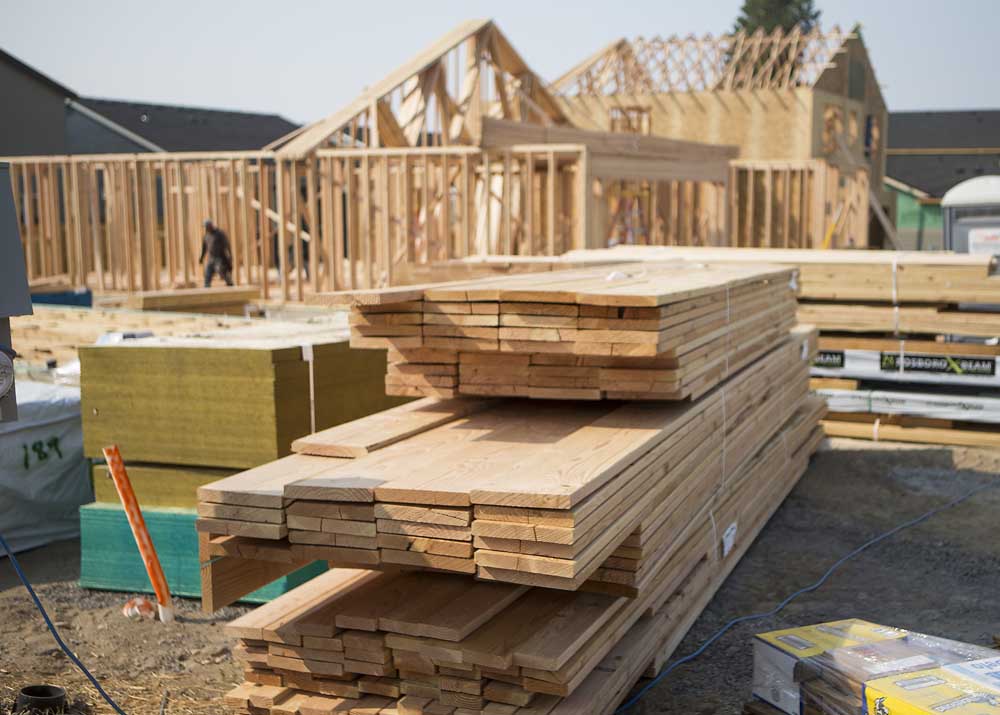Lumber price hikes push up home prices
Published 5:00 am Tuesday, September 1, 2020

- Piles of lumber and other building materials sit outside several homes under construction by D.R. Horton along Finn Place in Bend in August 2020.
In the market for a new home in Central Oregon? You’ve probably seen prices continue to rise.
But it’s not just demand causing home prices to rise in Central Oregon — the soaring cost of lumber is having an impact, too. The price of framing lumber, one of the key components of homebuilding, has more than doubled this year, according to the National Association of Home Builders.
That’s right, lumber is the latest hard-to-get commodity, joining toilet paper, hand sanitizer, meat, bicycles and other goods that had a surge in demand after the COVID-19 pandemic up-ended life as we knew it.
Lumber became scarce earlier this year when do-it-yourselfers bought up supplies to work on home projects during the quarantine period. All those new decks, gazebos, fences and other home additions required plenty of two-by-fours and plywood.
Just as demand increased, production from the mills across the country started to wane. Labor and social-distancing requirements slowed production, and it became difficult to find spare parts for equipment that was produced overseas.
“Similar to other manufacturing industries, when COVID hit, factories were shut down causing the gap in supply vs. demand to be that much greater,” said Jay Campbell, co-owner of Bend-based Woodhill Homes. “Record-setting demand in real estate and low-interest rates have kept lumber manufacturers trying to keep up.”
Ryan Jennings, operations and purchasing director for Redmond-based Hayden Homes, said the lumber industry has made progress but is still well behind schedule as it attempts to meet demand.
“They are becoming more efficient every day, but they still have not been able to get back to pre-pandemic production levels,” said Jennings.
Central Oregon mills were impacted too. In Gilchrist, 44 miles south of Bend, a mill owned by Vancouver-based Interfor announced it was laying off hundreds of workers due to weak economic conditions and challenges presented by COVID-19.
Mike Mackay, Interfor’s vice president of corporate development and strategy, said the company still has no plans to reopen.
Those shutdowns had a knock-on effect that rippled down to wood suppliers and box stores such as Home Depot and Lowe’s — many have struggled to keep shelves stocked.
“Nobody could foresee the explosion of demand from DIY projects during quarantine, and I think people were also surprised by a resilient market for new housing,” said Nick Smith, spokesman for the American Forest Resource Council. “Now both producers and buyers are scrambling to meet the demand.”
A thousand board feet of lumber costs more than $800 today compared to pre-pandemic costs of $300 per thousand board feet.
How do these cost hikes impact the price tag of a house? It’s adding between $15,000 and $20,000 to the cost, said Jennings. Lumber makes up around 20% of the cost of building a house, he said.
Reynolds said even though costs are higher, improving construction efficiencies and working with supplies has helped control costs.
“We are pretty darned efficient. We negotiate on larger volumes,” he said.
As lumber prices continue to climb higher, demand for homes in Central Oregon remains unrelenting, said David Gilmore, a broker for Coldwell Banker Bain in Bend.
“From low inventory and increasing demand to increased costs of purchasing land, those factors are certainly affecting home prices,” said Gilmore. “Most of what is under construction has been pre-sold and demand has been so strong many builders have even sold their model homes.”
Average home prices in Bend are up 5.7% year-on-year to $475,132, according to data compiled by Zillow. In Redmond, the one-year price change is up 6.3% to an average price of $340,217.
What is next for homebuilders and homebuyers looking to control costs? It may just be a matter of waiting until the hot timber market cools off. Industry insiders see the current surge in price to level off later this year or 2021.
“We expect numbers to remain high but not at these levels for long,” said Pete Stewart, president and chief executive officer of Forest2Market, a global provider of timber prices and market data.
“Both imported lumber and domestic production should ramp up,” added Stewart. “This will put more supply on the market and dampen prices somewhat.”






